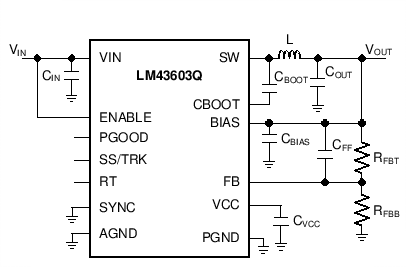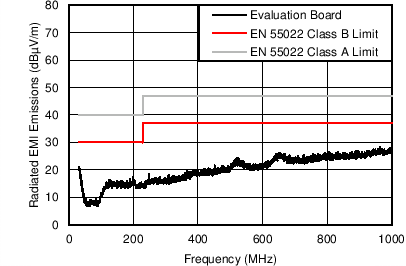ZHCSDR3C April 2015 – October 2017 LM43603-Q1
PRODUCTION DATA.
- 1 特性
- 2 应用
- 3 说明
- 4 修订历史记录
- 5 Pin Configuration and Functions
- 6 Specifications
-
7 Detailed Description
- 7.1 Overview
- 7.2 Functional Block Diagram
- 7.3
Feature Description
- 7.3.1 Fixed Frequency Peak Current Mode Controlled Step-Down Regulator
- 7.3.2 Light Load Operation
- 7.3.3 Adjustable Output Voltage
- 7.3.4 Enable (EN)
- 7.3.5 VCC, UVLO, and BIAS
- 7.3.6 Soft-Start and Voltage Tracking (SS/TRK)
- 7.3.7 Switching Frequency (RT) and Synchronization (SYNC)
- 7.3.8 Minimum ON Time, Minimum OFF Time and Frequency Foldback at Dropout Conditions
- 7.3.9 Internal Compensation and CFF
- 7.3.10 Bootstrap Voltage (BOOT)
- 7.3.11 Power Good (PGOOD)
- 7.3.12 Overcurrent and Short-Circuit Protection
- 7.3.13 Thermal Shutdown
- 7.4 Device Functional Modes
-
8 Applications and Implementation
- 8.1 Application Information
- 8.2
Typical Applications
- 8.2.1 Design Requirements
- 8.2.2
Detailed Design Procedure
- 8.2.2.1 Custom Design With WEBENCH® Tools
- 8.2.2.2 Output Voltage Setpoint
- 8.2.2.3 Switching Frequency
- 8.2.2.4 Input Capacitors
- 8.2.2.5 Inductor Selection
- 8.2.2.6 Output Capacitor Selection
- 8.2.2.7 Feed-Forward Capacitor
- 8.2.2.8 Bootstrap Capacitors
- 8.2.2.9 VCC Capacitor
- 8.2.2.10 BIAS Capacitors
- 8.2.2.11 Soft-Start Capacitors
- 8.2.2.12 Undervoltage Lockout Setpoint
- 8.2.2.13 PGOOD
- 8.2.3 Application Performance Curves
- 9 Power Supply Recommendations
- 10Layout
- 11器件和文档支持
- 12机械、封装和可订购信息
1 特性
- 符合汽车应用要求 认证
- 具有符合 AEC-Q100 标准的下列结果:
- 器件温度 1 级:–40°C 至 +125°C 的工作结温范围
- 27µA 稳压静态电流
- 可在轻负载条件下实现高效率(DCM 和 PFM)
- 符合 EN55022/CISPR 22 电磁干扰 (EMI) 标准
- 集成同步整流
- 可调频率范围:200kHz 至 2.2MHz(默认值为 500kHz)
- 与外部时钟频率同步
- 内部补偿
- 与陶瓷、固态电解、钽和铝电容器等大多数组合搭配使用时均可保持稳定
- 电源正常标志
- 软启动至预偏置负载
- 内部软启动:4.1ms
- 可由外部电容器延长的软启动时间
- 输出电压跟踪功能
- 程序系统欠压闭锁 (UVLO) 精确使能
- 具有断续模式的输出短路保护
- 过热关断保护
- 使用 LM43603-Q1 并借助 WEBENCH® 电源设计器创建定制设计方案
3 说明
LM43603-Q1 稳压器是一款易于使用的同步降压直流/直流转换器,能够驱动高达 3A 的负载电流,输入电压范围为 3.5V 至 36V(最大绝对值 42V)。LM43603-Q1 以极小的解决方案尺寸提供优异的效率、输出精度和压降电压。扩展系列产品能够以引脚到引脚兼容封装提供 0.5A、1A 和 2A 负载电流选项。采用峰值电流模式控制来实现简单控制环路补偿和逐周期电流限制。可选 功能 包括可编程开关频率、同步、电源正常标志、精确使能、内部软启动、可扩展软启动和跟踪,可为各种 应用提供灵活且易于使用的平台应用中对通道损失进行线性补偿。轻载时的断续传导和自动频率调制可提升轻载效率。此系列只需要很少的外部组件,并且引脚排列可实现简单、最优的印刷电路板 (PCB) 布局布线。保护功能 采用了 包括热关断、VCC 欠压锁定、逐周期电流限制和输出短路保护。LM43603-Q1 器件采用 HTSSOP (PWP) 16 引脚引线式封装 (6.6mm × 5.1mm × 1.2mm)。LM43603A-Q1 版本针对 PFM 操作进行优化,推荐用于新设计。该器件与 LM4360x 和 LM4600x 系列实现了引脚对引脚兼容。
简化原理图

辐射发射图
12 VIN 到 3.3 VOUT,FS = 500kHz,IOUT = 3A
